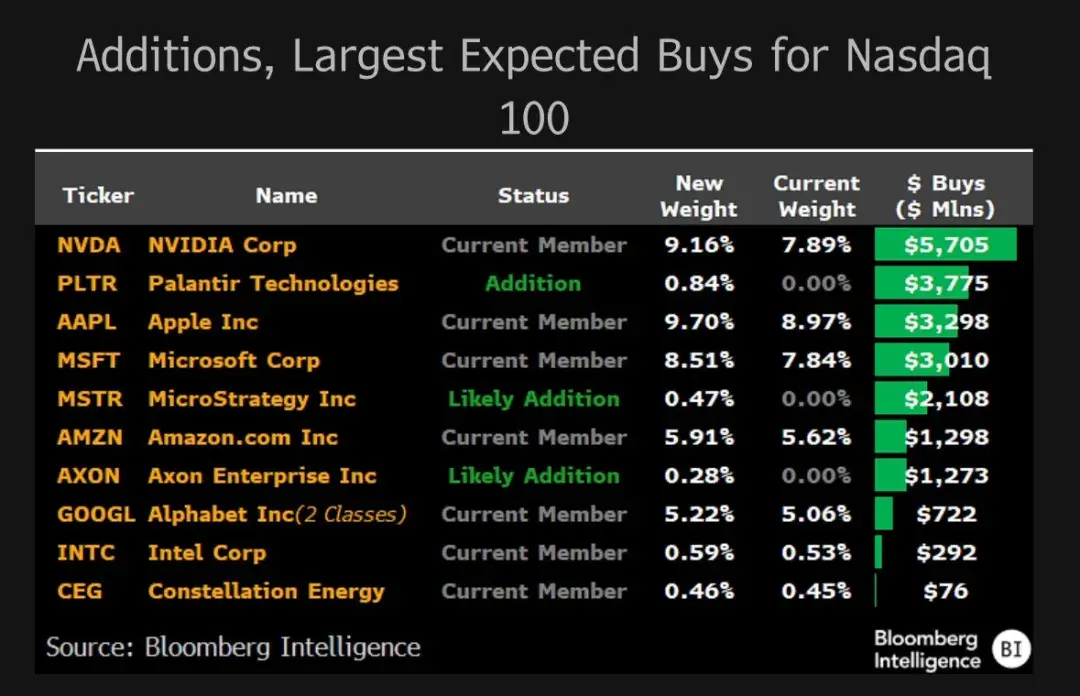Author: Carbon Chain Value
On December 13, Nasdaq officially announced the annual restructuring results of the Nasdaq 100 Index. Among them, MicroStrategy (MSTR), which claims to be a Bitcoin company and has seen explosive growth this year, will be added to the index and become one of the 75 largest non-financial companies on Nasdaq. It is reported that this addition will exponentially increase the Nasdaq 100 Index's exposure to Bitcoin and will expose MSTR to billions of dollars in passive investment. Currently, the Nasdaq 100 Index tracks the largest non-financial companies listed on the Nasdaq exchange, including market leaders such as Apple, Nvidia, Microsoft, Amazon, Meta, Tesla, and Costco.

CoinDesk senior analyst James Van Straten stated that MicroStrategy's inclusion in the Nasdaq 100 Index can be seen as the second biggest news of 2024, second only to the Bitcoin spot ETF listed in the U.S. These funds typically buy at any price level every month, which will add another buyer for MSTR, as Michael Saylor continues to issue at market price (ATM), diluting shareholders but expanding the buyer base.
Bloomberg senior ETF analyst Eric Balchunas mentioned on social media that MicroStrategy's addition to the Nasdaq 100 Index symbolizes a shift in the times.
Some are curious: what is MSTR's current weight in the index? Eric Balchunas stated that they estimate it will receive a weight of 0.47%, making it the 48th largest holding. This weight corresponds to approximately $2.1 billion in purchases through all ETFs tracking the index, which have a total value of $451 billion. They did not include SMA or CIT or any active strategies, so the final amount may be slightly higher.
However, another Bloomberg ETF analyst, James Seyffart, warned that MicroStrategy's inclusion in the index may be short-lived, as the company's value comes almost entirely from its Bitcoin holdings rather than its actual operating business, meaning the company could be reclassified as a financial company in March. MicroStrategy founder and executive Michael Saylor has even stated that he plans to transform the company into a "Bitcoin bank," making it less like a tech company.
Market views suggest that the SPDR S&P 500 Trust (SPY), currently the largest ETF with approximately $650 billion in assets under management, may need to include MSTR to compete with rivals. In that case, millions of investors would indirectly invest in Bitcoin, thereby increasing the flywheel effect.
The restructuring results of the Nasdaq 100 Index, QQQ, and related ETFs will take effect before the market opens on December 23.
Review of MicroStrategy's Bitcoin Strategy
Since mid-2020, MicroStrategy co-founder and chairman Michael Saylor decided to invest in Bitcoin as a hedge against inflation. The company initially used cash for acquisitions and has now shifted to using proceeds from issuing and selling stock and convertible bonds to enhance its purchasing power.
According to previous reports from Zhitong Finance, this strategy, along with the surge in Bitcoin's value, has helped MicroStrategy outperform all major U.S. stocks, including AI leader Nvidia. Since August 2020, MicroStrategy's stock price has risen over 2500%. During the same period, Bitcoin has increased by about 660%.
As of November 8, 2024, the company, headquartered in Tysons Corner, Virginia, holds a total of 423,650 Bitcoins, with a total purchase price of $25.6 billion and an average cost of $60,324 per coin. Currently, MicroStrategy is the largest publicly traded holder of Bitcoin, aside from BlackRock.
Additionally, according to reports from Wall Street, MicroStrategy has adopted "BTC Yield" as a metric to measure its Bitcoin acquisition strategy. MicroStrategy explains that the concept of BTC Yield refers to the percentage change in the number of Bitcoins owned by the company per share between two dates.
Specifically, as of November 17, assuming all of the company's convertible debt has been converted into stock, each 1,000 shares of outstanding stock would own 1.29 Bitcoins. This ratio has increased by 41.8% compared to December 31 of last year, when each 1,000 shares owned only 0.91 Bitcoins. MicroStrategy refers to this 41.8% increase as the "year-to-date BTC Yield."
This yield can be calculated over different time periods, such as quarterly or year-over-year, or by selecting any two dates with data for comparison.
Recently, the BTC Yield has shown a rapid upward trend. Just four weeks ago, MicroStrategy announced in a press release that the "year-to-date BTC Yield has reached 26.4%," a significant increase from 17.8% on September 30.
When MicroStrategy first adopted BTC Yield as a key performance indicator, the company ambitiously stated that starting next year, they would strive to raise this metric to a range of 4% to 8%.
What is the Nasdaq 100 Index?
According to official information, the Nasdaq 100 Index consists of the 100 largest non-financial companies listed on the Nasdaq stock market, with a history dating back to January 1985—nearly 40 years ago—when it was launched alongside the Nasdaq Financial 100™ Index, which comprises the 100 largest financial stocks listed on Nasdaq. These indices serve as benchmarks for financial products such as options, futures, and funds. The Nasdaq 100 is rebalanced every December, with the Friday coinciding with the quarterly expiration of stock index futures, stock index options, stock options, and individual stock futures (referred to as quadruple witching expiration day).
The Nasdaq 100 Index is the basis for the Invesco QQQ Trust (Nasdaq: QQQ), which aims to provide investment results that correspond to the performance of the Nasdaq 100 Index (before fees). Additionally, options, futures, and structured products based on the Nasdaq 100 Index and Invesco QQQ Trust are also traded on multiple exchanges.
免责声明:本文章仅代表作者个人观点,不代表本平台的立场和观点。本文章仅供信息分享,不构成对任何人的任何投资建议。用户与作者之间的任何争议,与本平台无关。如网页中刊载的文章或图片涉及侵权,请提供相关的权利证明和身份证明发送邮件到support@aicoin.com,本平台相关工作人员将会进行核查。




